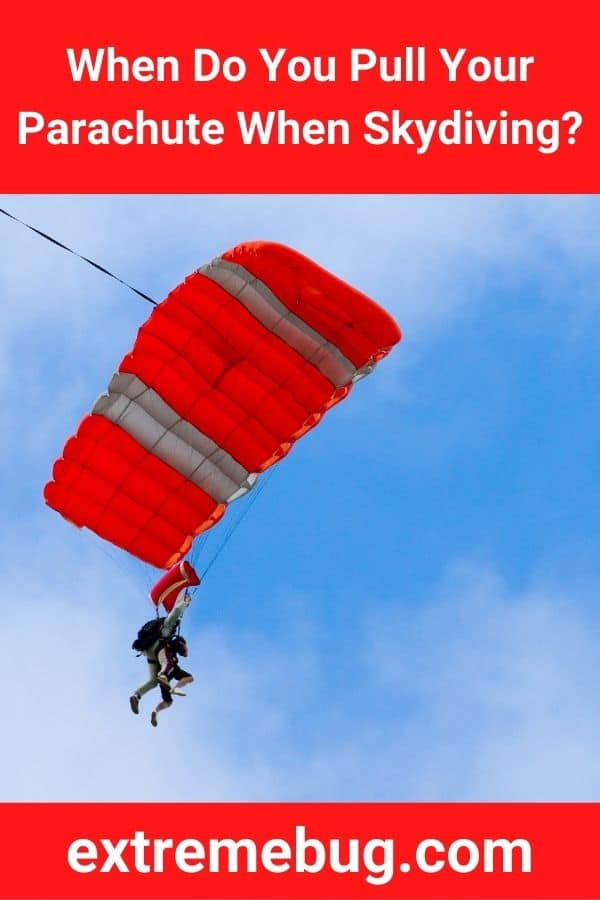Skydiving is not just as simple as just jumping out of a plane.
There are lots of things to think about whilst in the sky, for example when does the parachute need to be deployed.
In answer to your question, it depends on how experienced you are as a skydiver, the descent and the skydiving conditions. Typically, skydivers would open their parachute between 6,000ft and 3,000ft. More experienced divers would freefall for longer than tandem jumpers.
Let’s explore this a little bit further below.
| Type of skydiver | Altitude |
| Pro diver | 4,000ft |
| Tandem jumper | 6,000ft |
| Trainee solo diver | 5,000ft |
The above table is just world averages.
It completely depends on you, your weight and height, the type of parachute you have, and the weather conditions.
It is important that you listen to your training/ use your knowledge to determine when you open your parachute.
How long do you fall before opening your parachute?
Again, this does depend on your experience level and preference.
Let’s say you are an experienced skydiver.
You would jump out of the plane at around 15,000ft and would freefall for around 10,000ft.
Leaving you to open your parachute at 5,000ft.
It would take around 60 seconds to fall 10,000ft as you will be traveling between 110mph and 130mph!
However, this is just an average.
The more experienced you are, you can change your body movements to make yourself more aerodynamic.
This means you can travel through the air much quicker.
The above example is based on the ‘standard’ face to earth position.
This position will make you incredibly aerodynamic.
The more experienced you are the more you will shake up the positions!
What happens when you open your parachute too early?
It is an easy mistake to make, opening your parachute too early.
Or you might purposely open your parachute too early to get the amazing views for longer.
As nice as this sounds, it isn’t recommended.
When you open your parachute too early, you are putting yourself and others in all kinds of danger.
Firstly, let’s think about if you were to open your parachute too early and you were the first out the aircraft and people are meant to be following you.
If you pull your parachute too early, you could vertically collide with the other jumpers.
Not only putting yourself at risk but others too!
Another thing to think about is the temperature at higher altitudes.
If you were to jump at around 15,000ft and pull your parachute at 10,000ft the air would be extremely thin and extremely cold.
Could you imagine that wind?! Because of the wind, you will have to constantly steer and make sure you don’t lose sight of the drop zone.
This can be really mentally challenging and make you tired as you will have to be doing this for about 20 minutes.
As well as all this, you could get hypoxia which is when you have low levels of oxygen in the blood.
You might get shortness of breath, coughing, wheezing, and confusion.
It is a lot to contend with and in short, it is recommended that you follow your training and try not to open your parachute dramatically early.
What is the lowest altitude you can open your parachute?
So, we know what happens when you deploy your parachute too early, but what happens when you deploy your parachute too late?
In the US, the minimum altitude to open your parachute for experienced skydivers is 2,000ft and for tandem/ novice jumpers it is 5,000ft.
Normally, these rules are usually observed and well respected.
But, what about if something stops you from opening your parachute earlier?
Firstly, it is likely your parachute will be fitted with an AAD (Automatic Activation Device) which will automatically deploy your parachute if you have not by the time you get to a certain altitude.
This will be pre-set for you.
Secondly, it is important that you remember your training and you respect the rules set by the governing body of skydiving.
Having said that, these aren’t the ‘laws’ of skydiving.
If you wanted to open your parachute at a slightly lower altitude and it is safe to do so, you won’t get into any trouble and it won’t cause you any harm.
It is just important to remember that your landing might be a little bit bumpier.
What happens after you open your parachute?
You’ve been freefalling for around 60 seconds.
The wind is loud, and you are flying!
Then suddenly your parachute opens and calm returns.
You are falling a lot slower, you can see breathtaking views, catch your breath and talk to your instructor.
On average, the descent from your parachute opening to your landing is around 5 minutes if you are on a tandem jump and for experienced solo jumpers, it is around 3 minutes.
Again, how long the descent is depending on a lot of factors such as weather conditions, your height and weight, and how big the parachute is.
For example, if you are heavier and have a smaller parachute, you will fall more quickly.
In short, after the parachute is open, you can relax and take in beautiful scenery, and process what has just happened!
Is steering a parachute difficult?
Novice skydivers usually think that steering a parachute is the hardest part of skydiving.
I mean, it is a pretty big, heavy piece of kit!
But it’s actually pretty simple.
Either side of the parachute will be toggled.
When you pull the right toggle, you will turn right.
When you pull the left toggle, you will turn left.
Easy peasy.
You should bear in mind how hard you pull the toggle.
When you pull the toggle hard, you will turn very sharply.
If you gently pull the toggles, you will turn slowly.
When you are training, you will have a radio when you jump so ground instructors can direct you and tell you where you need to be.
Steering the parachute is easy to learn but is a skill you will always be developing.
How do you know when to open your parachute?
All skydivers will wear an altimeter on their left wrist (right wrist if you are left-handed).
The altimeter will tell you how high or low you are.
Experienced divers might have an altimeter installed in their helmets and you can even get audio altimeters!
All of these devices will tell you the altitude you are at and you can make a decision on whether to open your parachute or not.
Having an altimeter on your person is mandatory and you will not be permitted to jump without one.
Does it hurt when your parachute opens?
You might have seen on films or YouTube videos someone jumping out of a plane and then pulling the parachute and it’s a sudden jolt.
Looks painful right?
This is a huge skydiving misconception.
This myth makes sense as you will be freefalling at around 125mph and suddenly slowing down to 5mph.
However, it actually isn’t painful at all!
The canopy takes about 2-3 seconds to fully open, so you don’t just suddenly come to a near enough stop.
You will gradually slow down so there is no pull.
Skydivers have also said you don’t get the feeling of your stomach ‘dropping’ like you do on a rollercoaster.
In conclusion, skydiving as fun and exhilarating as it is, is also very technical.
When it comes to deploying your parachute, you should remember your training (or let your instructor take the reins).
It is also important for you to deploy your parachute at a time you feel most comfortable.
The altitudes we have mentioned in this article are just worldwide averages.
As an extreme sport, skydiving poses many risks for accidents, so it is important to feel knowledgeable and confident.







